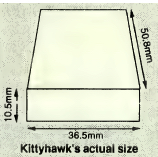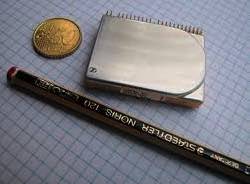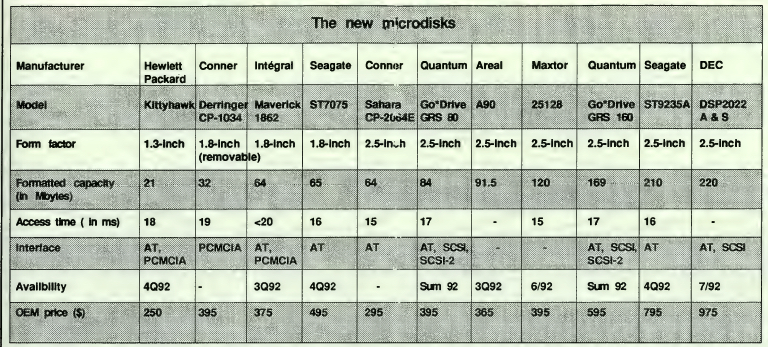History (1992): Kittyhawk HDD From HP in 1.3-Inch Form Factor
Tiniest drive ever seen
By Jean Jacques Maleval | June 26, 2020 at 2:21 pmHewlett-Packard (Palo Alto, CA) is launching the tiniest HDD ever seen, in a 1.3-inch form factor, smaller than a small match box, with a 21.4MB capacity.


You have to see it to believe it. The Kittyhawk only measures 50.8mm long, 36.5mm large and 10.5mm wide, 12% less than a matchbox, for 32 grams.
And nothing is missing: two 3.4cm wide magnetic platters in a glass-based support (not the usual aluminum), a 51,000bpi and 2,400tpi density, a motor spinning at 5,400 rpm (resulting in a latency of 5.6ms), an actuator with 50% nanoslider heads originated from Read Rite (Milpitas, CA) to read and write, flying on 3 of the 4 sides of the media, a tiny controller on only 7 chips (instead of 30 generally used) and specially developed by AT&T Microelectronics (Berkeley Heights, NJ) with an AT interface.
The performances of the drive can largely compare with those of standard Winchesters with an 18ms access time and a sustained transfer rate of 9MB/s.
Operating shock of 100Gs
You can easily throw it at someone’s face. Its shock resistance is 100G operating (and a 225G non-operating shock), something never seen before since competitors topped at 20G.
According to Patrice Bernou, in charge of the storage peripherals of the French HP’s subsidiary in Paris, it would mean that you can drop the drive while it’s operating from one meter high with no risk. This amazing characteristic was reached by using a system similar to air bag collision sensors as in cars. The chip detects impending impact, and causes the drive to instantly revert to a protective mode to ensure no data loss. Announced MTBF is 300,000 hours and the module performs 100,000 start/ stops with no failure of mechanism, according to H-P.
Power consumption, using 5V DC, reaches a maximum 2.8W at start-up, 1.5W to read, 1.7W to write, 15mW in sleeping mode.
This technology marvel offers today a formatted 21.4MB capacity (another model with just one platter is also offered with 14MB), but HP is already mentioning 200MB for 1995.
The first interfaces to be offered will be AT and PCMCIA, in this last one with a connector that doesn’t plug into the back of the drive, too narrow, but on the side of the unit. On account of the standard PCMCIA height limitation, a fourth head could not be added outside of one of the two platters.
The Kittyhawk project was quickly developed since it started in August 91.
HDDs to become a consumer product?
The size of the Kittyhawk aims it to other applications then just the smallest notebook computers. HP envisions microcomputers with screens behind each seat of an airplane or in hotel rooms were customers could plug in their Kittyhawk to work.
The US manufacturer speaks in this way of HP Kittyhawk Personal Storage Module (PSM) and developed its unit like a future widely-used product, a consumable that could fit in a pocket and be exchanged.
HP aims it to any devices with microprocessors that could be enhanced with an extra mass memory: phones, car navigation systems, copy machines, modems, fax machines, printers, measuring systems, data acquisitions, process control units, robots, video cameras, game machines, patient monitoring devices, etc.
HP mentions the possibility of disk arrays: “More than 60 Kittyhawk PSMs can fit within the form factor of a single 5.25-inch disk drive, with room still remaining for necessary electronic connections.”
$250 In OEM quantities
Unit price, $250 in OEM quantity 20,000 to 50,000, is high, but we know that in the disk drive industry, prices quickly drop with competition and mass production. Only flash cards with semiconductors, still 3x more expensive, could be a concern for the microdisk. Recently, Intel launched a 20MB flash card for $611.50 in OEM quantities.
Evaluation units of the Kittyhawk are available today for $450.
Some observers think that the Kittyhawk could be integrated before year end in a small HP microcomputer via its Corvallis-based division in Oregon, that manufactures the HP95LX palmtop.
“Number of OEMs have already chosen the new storage module instead of solid-state technology for their designs of several mobile computing devices, digital imaging peripherals and portable communication products,” announced HP.
Manufactured by Citizen Manufacturing should start at year end and will be handled by a specialist in miniaturization, the Japanese watchmaker Citizen Watch Co., Ltd., that also is the second largest supplier of floppy disk drives in the world.
“We can’t manufacture a device this compact the same way we make a conventional disk drive, because the components are too small to be manipulated by human hands. The fact that Citizen has the technology to find screws you can’t even see with the naked eye speaks to their ability to overcome this issue,” said Bruce F. Spenner, GM of HP’s disk memory division.
Scheduled manufacturing rate is 50,000 units per year. But you can imagine that the production will not be easy as the drives will have to integrate a large number of new, thus expensive, components, especially heads and glass media.
We were generally used to see start-ups, rather than large companies like HP already well-settled on the market, taking risks with new form factors.
According to Robert McGraw, market development manager of HP’s disk memory division in Boise, ID, HP’s entire mass storage group should report close to $750 million sales in 1991, an increase close to 100% compared with 1991 , growth reaching 65% from 1990 to 1991. Actually, more than half of the sales of the group go to other customers than HP. McGraw names AT&T, NCR, NeXT Computer, Sequent and Storage Technology.
This group manufactures Winchester disks and subsystems, optical libraries and disk drives, cartridge and tape drives, as well as DAT units, in different sites in Bristol, UK, Boise, ID and Greeley, CO.
Is smaller possible?
Is smaller possible or have we reached the limits of miniaturization for HDDs? After this 1.3-inch form factor, we’re already hearing about 0.9 inch, which means a volume two times smaller: two small drives this time in a small match box.
The announcement made by HP who had never came under 3.5 inches, is even more surprising as 1.8-inch drives, two times larger, those promised by Aura, IBM, Integral Peripherals or Ministor, are far from being in full production.
But HP doesn’t leave out the possibility of completing its line of HDDs. “We will enter the 2.5-inch form factor, when the market requires it,” says Dayrell Drake, disk OEM market development in Bristol, UK.

This article is an abstract of news published on the former paper version of Computer Data Storage Newsletter on issue ≠53, published on June 1992.












 Subscribe to our free daily newsletter
Subscribe to our free daily newsletter
